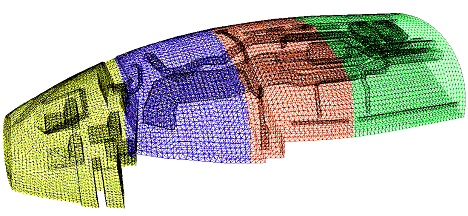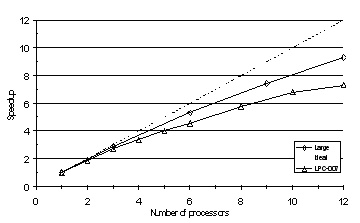Utilising networks of standard office PCs to run SMARTFIRE in parallel.
Over the past five years, the use of Computational Fluid Dynamics (CFD) based fire field modelling has become increasingly popular. However, there are a number of obstacles preventing the widespread use of fire-field modelling, one of the most significant being the excessive computational resource required to perform reliable fire simulations. The need for huge amounts of computational power is partially mitigated by the ever increasing performance capabilities of PCs at a reasonable cost. However more computing resource will always be required to run more complex problems in shorter timeframes. Parallel processing has the potential to meet this computational demand.
In the past, parallel processing techniques have been successfully applied to fire modelling simulations but these made use of expensive, specialised, parallel processing equipment [click here for details]. While useful for research, this is of little interest to practical fire engineers. Modern day parallel processing is generally based around attaching commodity PC parts together using dedicated networking, e.g. Beowulf clusters. Although many such systems have been built and successfully used, little attention has been given to utilising conventional Microsoft™ Windows PCs attached to a Local Area Network (LAN). Although inferior in performance to a dedicated Beowulf style cluster this computing resource is freely available in most design offices. Most office based PCs will be idle for large parts of the day, particularly in the evening, and this could be utilised for parallel processing. Parallel processing also allows increased problem sizes to be tackled as more memory is available than can be found on single processor.
A parallel implementation of the SMARTFIRE CFD code has been performed based on a systematic partitioning of the problem domain onto an arbitrary number of sub-domains. Each sub-domain is computed on a separate processor and runs its own copy of the SMARTFIRE CFD code. At the boundary of the domain partitions each sub-domain needs to communicate with its neighbouring sub-domain to exchange necessary data. This communication was implemented using the MPI parallel library. In Fig 1 below the mesh is partitioned into 4 sub-domains.

Fig 1 – Complex aircraft mesh partitioned into 4 sub-domains.
There are essentially two types of parallel network that are typically available to a fire engineer. These are homogeneous and heterogeneous networks. A homogeneous network of computers is composed of a number of ‘identical’ machines, e.g. same processor specification. A heterogeneous network of computers is composed of a number of ‘non-identical’ machines, different processor specification. In this work all the heterogeneous machines used the same operating system, i.e. Windows.
A homogeneous network of 12 800MHz Pentium III based PCs was available to test the parallel performance of the SMARTFIRE CFD based fire modelling software. The network configurations were tested with two fire modelling scenarios, one consisting of ~26,000 cells (LPC-007) and the other consisting of ~100,000 cells (large). Table 1 indicates the relative speed up of the computational jobs compared to the speed of a single 800MHz Pentium III based PC. These results are represented graphically in Fig 2, which also presents the theoretical ideal speedup.
Table 1 – Speed up of computational jobs compared to the speed of a single computer
|
No. Computers |
2 |
3 |
6 |
12 |
|
~26,000 cells |
1.90 |
2.70 |
4.55 |
7.31 |
|
~100,000 cells |
1.95 |
2.86 |
5.31 |
9.30 |

Fig 2 - Speed up of computational jobs compared to the speed of a single computer.
This increase in speed vastly increases the amount of work that can be achieved by the fire engineer. The ~100,000 cell case required some 54hrs 10min to run. With 12 processors this job was completed within 5hrs 50mins - well within a working day - allowing the fire engineer to set up the problem, run the problem, analyse the results and start the next simulation, all within a single working day.
A number of heterogeneous network configurations were also studied and are summarised below. In order to take advantage of a heterogeneous network of PCs a dynamic load balancing scheme was devised to determine the relative computational power of each processor. The relative computational performance of the processors obtained from running serial SMARTFIRE are listed below in table 2. Entry (b, ii) indicates the relative performance of a dual processor PC when both processors are utilised.
Table 2 – Relative computational performance of processor compared to 733MHz Intel Pentium III
|
|
CPU |
k |
|
(a) |
Intel PIII 733 |
1.0 |
|
(b, i) (b, ii) |
Intel PII 450 2 x Intel PII 450D |
0.63 1.08 |
|
(c) |
Intel P200 MMX |
0.23 |
Table 3 - Speedup for heterogeneous network configurations using dynamic load balancing
|
Network Config |
CPUs |
Ideal |
Actual 26K |
Actual 100K |
|
1 |
(a) + (b) |
1.63 |
1.64 |
1.64 |
|
2 |
(a) + (c) |
1.23 |
1.19 |
1.21 |
|
3 |
(a) + (b) + (b) |
2.08 |
2.07 |
2.07 |
|
4 |
(a) + (b) + (c) |
1.86 |
1.69 |
1.84 |
|
5 |
(a) + (a) + (b) + (b) |
3.08 |
2.85 |
2.91 |
|
6 |
(a) + (b) + (b) + (c) |
2.31 |
2.12 |
2.24 |
|
7 |
(a) + (b) + (c) + (a) |
2.86 |
2.34 |
2.67 |
From table 3 it can be seen that good computational performance can be obtained from a variety of heterogeneous networks. It can be seen that most of the potential speedup performance was obtained from all the configurations. For network configuration 2 the performance is better than anticipated. This could be due to effects such as better cache/CPU utilisation.
As parallel SMARTFIRE is designed to be used on a conventional LAN of PCs some provision for other users using the same PC on the LAN had to be undertaken. This was necessary for two reasons, first the parallel SMARTFIRE job would be held up if just a single node became busy with another process, and secondly the other user’s process would be detrimentally affected by parallel SMARTFIRE. To mitigate both of these effects parallel SMARTFIRE monitors the workloads on all of its parallel computers. If a computer is found to have an additional computational load then the problem is redistributed amongst the processors so that only a small amount of processing, about 5% of the original load, is placed on the ‘busy’ processor for parallel SMARTFIRE.
The parallel implementation of SMARTFIRE allows the efficient solution of large fire field modelling problems. Furthermore this is achieved on non-specialised PC equipment which may typically exist in many fire safety engineering offices.
Reference:
Parallel CFD based Fire Modelling on Conventional Office Based PCs, Grandison A.J., Galea E.R., Patel M.K., Ewer J., Proceedings of the Joint DCABES and ICPACE Meeting, ISBN 1-904521-27-4, CMS Press, University of Greenwich, UK, 2005, pp43-46
The Development of Parallel Implementation for a CFD based fire field model utilising conventional office based PCs. Grandison A.J;, Galea E.R., Patel M.K., Ewer J. Journal of Applied Fire Science, Vol 12(2) 137-157, 2003-2004
E R Galea, N Hoffmann and D Berhane. Large-Scale Fire Field Modelling - the Route to General Use via Parallel Processing. Proceed INTERFLAM '93, Oxford, 1993.
See publications # 56, 55, 50, 44, 43, 184,185.

